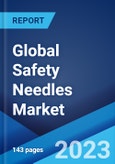The global safety needles market size reached US$ 2.6 Billion in 2022. Looking forward, the market is expected to reach US$ 4.6 Billion by 2028, exhibiting a growth rate (CAGR) of 9.98% during 2022-2028.
Safety needles are used to deliver drugs, collect fluids from the body, and prevent the spread of needlestick injuries or infections associated with healthcare provision. They protect healthcare workers and patients from bloodborne pathogens and hazardous drug exposure. Some of the widely available safety needles are biopsy, Huber, cannula, pen, suture, prefilled, hypodermic, fine aspirating, intravenous (IV) catheter, blood collection, arteriovenous (AV) fistula, and spinal anesthesia and epidural. Nowadays, automated pen needles with built-in safety features are being introduced to provide various benefits in insulin injection.
Safety needles are used to deliver drugs, collect fluids from the body, and prevent the spread of needlestick injuries or infections associated with healthcare provision. They protect healthcare workers and patients from bloodborne pathogens and hazardous drug exposure. Some of the widely available safety needles are biopsy, Huber, cannula, pen, suture, prefilled, hypodermic, fine aspirating, intravenous (IV) catheter, blood collection, arteriovenous (AV) fistula, and spinal anesthesia and epidural. Nowadays, automated pen needles with built-in safety features are being introduced to provide various benefits in insulin injection.
Safety Needles Market Trends
Injections are considered a main source of infection in transmitting bloodborne diseases, such as Hepatitis B, D, and C and Human Immunodeficiency Virus (HIV). As a result, health agencies of several countries are implementing laws for safe injection practices, which represents one of the major factors impelling the growth of the market. Safety needles help reduce the incidences of iatrogenic infection and save costs. In addition, they are used to prevent the transmission risk of bloodborne viruses and protect patients from needlestick injuries while administering coronavirus disease (COVID-19) vaccines. Apart from this, due to the growing prevalence of chronic diseases and awareness about the risk associated with filled syringes, there is a rise in the adoption of prefilled syringes across the globe, which, in turn, is driving the market. Moreover, several health firms are introducing needle-based safety devices that can be attached to a conventional or prefilled syringe. Furthermore, initiatives undertaken by governing agencies of numerous countries for needle disposal are projected to aid the market growth. For instance, a program was launched in the City of Bloomington (United States) to install sharps containers in public parks and address the increasing number of used syringes.Key Market Segmentation
This research provides an analysis of the key trends in each sub-segment of the global safety needles market report, along with forecasts at the global, regional and country level from 2023-2028. The report has categorized the market based on product, application and end user.Breakup by Product:
- Active Safety Needles
- Passive Safety Needles
Breakup by Application:
- Drug Delivery
- Sample Collection
- Injection
Breakup by End User:
- Hospitals and Ambulatory Surgery Centers
- Diabetic Patients
- Family Practice
- Psychiatry
Breakup by Region:
- North America
- United States
- Canada
- Asia-Pacific
- China
- Japan
- India
- South Korea
- Australia
- Indonesia
- Europe
- Germany
- France
- United Kingdom
- Italy
- Spain
- Russia
- Latin America
- Brazil
- Mexico
- Middle East and Africa
Competitive Landscape
The competitive landscape of the industry has also been examined along with the profiles of the key players being B. Braun Melsungen AG, Becton Dickinson and Company, Boston Scientific Corporation, Cardinal Health Inc., Johnson & Johnson, Nipro Corporation, Novo Nordisk A/S, Retractable Technologies Inc., Smiths Group plc, Terumo Corporation and Vygon.Key Questions Answered in This Report:
- How has the global safety needles market performed so far and how will it perform in the coming years?
- What has been the impact of COVID-19 on the global safety needles market?
- What are the key regional markets?
- What is the breakup of the market based on the product?
- What is the breakup of the market based on the application?
- What is the breakup of the market based on the end user?
- What are the various stages in the value chain of the industry?
- What are the key driving factors and challenges in the industry?
- What is the structure of the global safety needles market and who are the key players?
- What is the degree of competition in the industry?
Table of Contents
1 Preface3 Executive Summary11 Value Chain Analysis13 Price Analysis
2 Scope and Methodology
4 Introduction
5 Global Safety Needles Market
6 Market Breakup by Product
7 Market Breakup by Application
8 Market Breakup by End User
9 Market Breakup by Region
10 SWOT Analysis
12 Porters Five Forces Analysis
14 Competitive Landscape
Companies Mentioned
- B. Braun Melsungen AG
- Becton Dickinson and Company
- Boston Scientific Corporation
- Cardinal Health Inc.
- Johnson & Johnson
- Nipro Corporation
- Novo Nordisk A/S
- Retractable Technologies Inc.
- Smiths Group plc
- Terumo Corporation
- Vygon
Methodology

LOADING...
Table Information
| Report Attribute | Details |
|---|---|
| No. of Pages | 143 |
| Published | November 2023 |
| Forecast Period | 2022 - 2028 |
| Estimated Market Value ( USD | $ 2.6 Billion |
| Forecasted Market Value ( USD | $ 4.6 Billion |
| Compound Annual Growth Rate | 10.0% |
| Regions Covered | Global |
| No. of Companies Mentioned | 11 |









